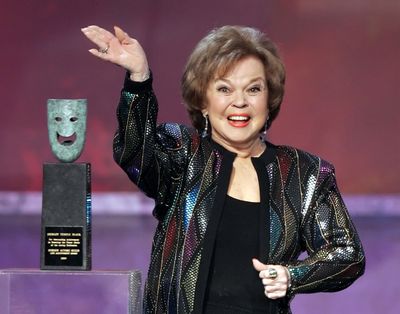Shirley Temple Black, child star, diplomat, dies
She lifted nation’s mood, served as its ambassador

Shirley Temple Black, who as the most popular child movie star of all time lifted a filmgoing nation’s spirits during the Depression and then grew up to be a diplomat, has died. She was 85.
Black died late Monday at her home in the San Francisco suburb of Woodside, according to publicist Cheryl Kagan. No cause was given.
From 1935 through 1938, the curly-haired moppet billed as Shirley Temple was the top box-office draw in the nation. She saved what became 20th Century Fox studios from bankruptcy and made more than 40 movies before she turned 12.
Other preteens, from Macaulay Culkin to Miley Cyrus, have been as famous in their time. But none of them helped shape their time the way she did.
Dimpled, precocious and oh-so-adorable, she was America’s top box office draw during Hollywood’s golden age, and her image was free of the scandals that have plagued Cyrus, Lindsay Lohan and so many other child stars – parental feuds, drugs, alcohol.
Shirley Temple remains such a symbol of innocence that kids still know the drink named for her: a sweet, nonalcoholic cocktail of ginger ale and grenadine, topped with a maraschino cherry.
Her hit movies – which included “Bright Eyes” (1934), “Curly Top” (1935), “Dimples” (1936), “Poor Little Rich Girl” (1936) and “Heidi” (1937) – featured sentimental themes and musical subplots, with stories of resilience and optimism that a struggling American public found appealing. She kept children singing “On the Good Ship Lollipop” for generations.
She was also a tribute to the economic and inspirational power of movies, praised by President Franklin D. Roosevelt himself for lifting America’s spirits during a gloomy time.
She was “just absolutely marvelous, greatest in the world,” director Allan Dwan told filmmaker-author Peter Bogdanovich in his book “Who the Devil Made It: Conversations With Legendary Film Directors.”
“With Shirley, you’d just tell her once and she’d remember the rest of her life,” said Dwan, who directed her in “Heidi” and “Rebecca of Sunnybrook Farm.” “Whatever it was she was supposed to do – she’d do it. … And if one of the actors got stuck, she’d tell him what his line was – she knew it better than he did.”
From 1935 to 1938, she was the most popular screen actress in the country and a bigger draw than Clark Gable, Joan Crawford or Gary Cooper.
But as she moved into her teens, she literally outgrew the movie business – audiences would not accept her in more mature roles – and Shirley Temple made her last film, “Mr. Belvedere Goes to College,” in 1949.
In 1999, the American Film Institute’s ranking of the greatest screen legends put Shirley Temple at No. 18 among the 25 actresses.
“I have one piece of advice for those of you who want to receive the lifetime achievement award: Start early,” she quipped in 2006 as she was honored by the Screen Actors Guild.
But she also said that evening that her greatest roles were as wife, mother and grandmother: “There’s nothing like real love. Nothing.” Her husband of more than 50 years, businessman Charles Black, had died a few months earlier.
Politics consumed much of her adult life after she married businessman Black in 1950 and was known as Shirley Temple Black.
An active Republican, she ran unsuccessfully for Congress in 1967. Two years later, she was appointed the U.S. delegate to the United Nations by President Richard Nixon.
From 1974 to 1976, Black was the U.S. ambassador to the West African nation of Ghana and later served as White House chief of protocol for President Gerald Ford. She also was an ambassador to Czechoslovakia from 1989 to 1992, a “substantive job” that was the best she ever held, Black told the Washington Post in 1998.
Black often underplayed her years as the little screen star whose blinding smile and bountiful talent rescued a studio. “Sometimes one scores a bull’s-eye purely by chance,” she wrote in her autobiography.
Black is survived by a son, Charlie Jr.; two daughters, Lori and Susan; a granddaughter; and two great-granddaughters.